120 Machine Manual
This narrative will describe, in detail, how each section of the system functions in order to help the user understand the cause and effect of each input and output. Inputs (electrical devices and signals) are discussed with references as to what occurs when they are triggered. A detailed list of each sensor and its function is located after this section. An input is a signal which informs the machine controller of an event occurring. An output is the machine controller sending the machine an instruction; outputs can be thought of as the signals and devices that do the work. A thorough understanding of the machine and how it functions will greatly aid in troubleshooting any problems that may arise.
CASE PACKER
Infeed
The Infeed Conveyor (MT1302) motor accepts the cartons from the upstream conveyor and delivers them to the side belts.
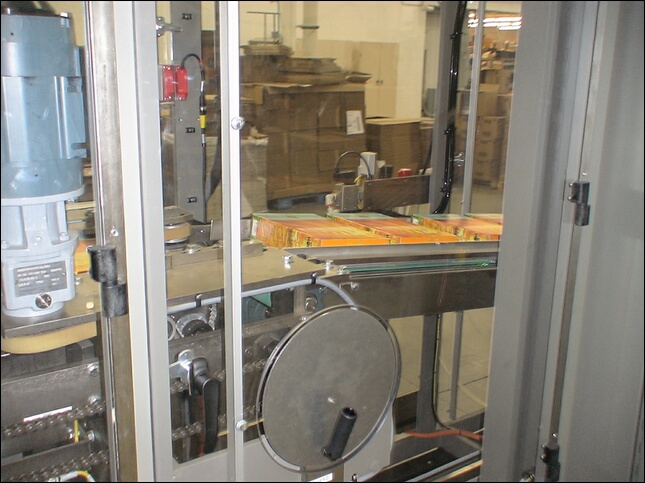
The Non-Operator Side Side Belt (MT1403) and Operator Side Side Belt (MT1406) motors launch the cartons into the downstacker flights. These side belts travel more quickly than the infeed conveyor to ensure proper gap between cartons.
Downstacker
The First Carton In Downstacker (PE31704) photo eye senses when the first carton is on the top of the downstacker flights, and the Second Carton In Downstacker (PE31703) photo eye senses when the second carton is on the top of the downstacker flights. As the side belts present a layer of cartons, the Downstacker Flights, driven by SM4 Fixed Flight 1, SM5 Fixed Flight 2, SM2 Adjustable Flight 1, and SM3 Adjustable Flight 2 servo motors, will lower by one product height, making room for the next layer. When the last layer is presented to the downstacker, the complete stack will be lowered to the bottom of the downstacker chamber, presenting the stack for the downstack pusher.
Downstack Pusher
Once the downstack pusher receives a stack complete signal from the downstacker, the downstack pusher virtual master begins its cycle.
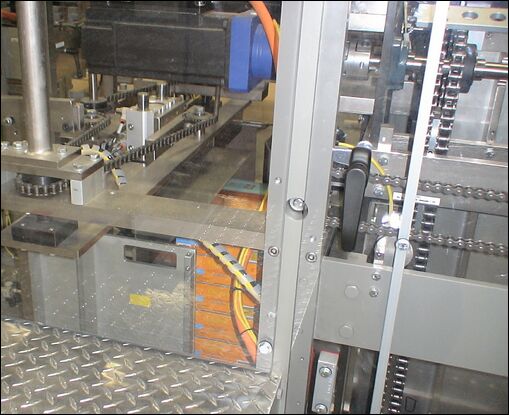
The Downstack Pusher (SM6) then moves the stack to the loader and returns to its starting position. The Product Conditioner (SV30703) solenoid valve extends a plate down, to the top of the product, to ensure any bulged cartons will clear and enter the case.
Loader
After the product has been cross-pushed into the load station, the Loader (SM7), which is cammed to the loader virtual master, moves the product into the case. If the Case Present At Load (PE31903) photo eye does not sense a case has been properly set up at the load station, the loader will not advance. The system will stop and prompt the operator to remove the case from the load station.
As the stack is moving toward the case, the Fun/Tucker and Funnel (SM9 and SM8) servo motors start to rotate into the case. At the same time, the Fun/Tucker In/Out and Funnel In/Out (SV30406 and SV30407) solenoid valves are activated to move the funnels ¾" toward the case. This action positions the funnel inside the score line of the case. The funnels then guide the product into the case and are retracted before the cartons are fully in the case.
Magazine
The Magazine Top Clip and the Magazine Bottom Clip (SV30705 and SV30707) solenoid valves open when the robot is moving toward the magazine. To open the case blank, rotating clips on each side of the case blank hold the back panel of the case while the robot pulls the front panel forward and down. After the robot has partially pulled the case from the magazine, the Magazine Rotate Clip (SV30306) solenoid valve opens the clips to release the case. The top clip closes sooner than the bottom and rotating clips. The bottom and rotating clips close after the case has been fully removed from the magazine. If the Case Packer Robot Vacuum (VS31806) vacuum switch from the robot is not made, a fault message is displayed.
The Magazine Advance Cylinder (SV05) will cycle if the Magazine Advance Switch (PX18) is not made and the Robot is not picking a case blank. If the cylinder cycles more than 10 times without meeting the Magazine Advance Switch, a fault message will be displayed.
The Magazine Advance (SV30401) solenoid valve actives a cylinder which moves the magazine advance chains forward with a ratcheting motion.
When the blanks in the magazine no longer block the Case Blanks Present (PE31803) photo eye, the HMI will indicate the magazine is low, a blue stack light will illuminate, and the horn will sound. If the magazine is not filled after 25 additional case blanks have been picked, the machine will stop.
Robot
The robot’s cycle stop position is at the magazine.
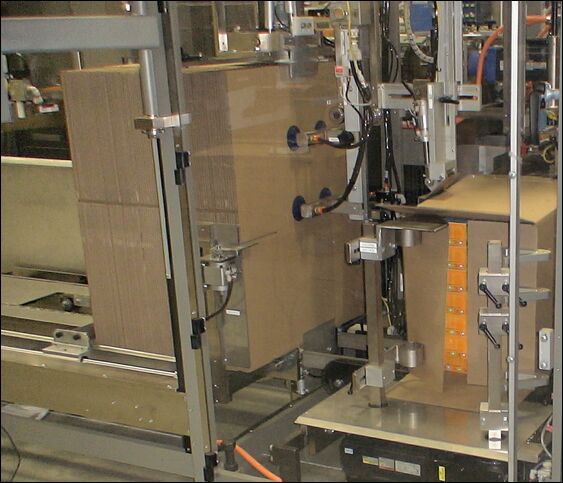
If the robot is signaled to pick a blank, the Robot Vacuum (SV30408) solenoid valve turns on vacuum. The robot proceeds with the new case to the load station. The Case Pusher (SV30403) extends to hold the case at the load station, keeping it vertical with the flights as it moves into compression. The initial move away from the magazine is the Robot X-Axis (SM12) move, which arcs down by adding the Robot Z-Axis (SM13) to place the case in the load station. The robot then moves up and around the case being loaded and proceeds to the magazine.
Flights
The Case Flights (SM14) servo motor matches the robot x-axis movement, and advances the loaded cases through tucking, gluing, and compression.
Load Station
When an empty case blank is set up in the load station, the Load Cup Lift (SV30801) solenoid valve extends the air cylinders, and the Load Vacuum (SV30308) solenoid valve turns on the vacuum. This action holds the case in position while loading. Before the case is moved out of the load station, vacuum is turned off and the cylinders are retracted.
Fun/Tuckers
The Funnel In/Out and the Fun/Tucker In/Out (SV30407 and SV30406) solenoid valves move the funnels into the case. The Funnel and Fun/Tucker (SM8 and SM9) servos are cammed to the case packer main virtual master for funneling the cartons into the case during loading. The funnel and fun/tucker are rotated to guide the cartons into the case. As the stack is being loaded into the case, the funnels retract while the Tucker (SM10) tucks the leading flap on the operator side of the case, and the Product Stop (SM11) partially closes the trailing flap on the operator side. Closing these flaps gives the carton stacks a surface against which to square as they are loaded into the case. As the loader retracts from the case, the funnel rotates away from the case. The fun/tucker rotates away, and continues to rotate, enabling the tuckers mounted on the back side to tuck the leading flap on the non-operator side of the case. As the case moves forward out of the load station and into compression, the fun/tucker and tucker move in unison to tuck the trailing vertical flap. The Distorted Case (PE31904) photo eye looks for the trailing edge of the case to ensure flaps are properly tucked.
Glue
Glue is applied to the vertical flaps as the case moves from the load station to compression. The Lower Glue Non-Operator Side, Lower Glue Operator Side, Upper Glue Non-Operator Side and Upper Glue Operator Side (SV30805, SV30806, SV30807 and SV30808) solenoid valves are all cammed to the case packer main virtual master. Glue is applied only if vacuum is made at the Load Vacuum (VS31708).
Compression
When the case reaches the compression station, the Case Stop (SV30402) solenoid valve extends to stop the top leading edge of the case, keeping it square. The case pusher and flights ensure that the case is pushed up against the stop.
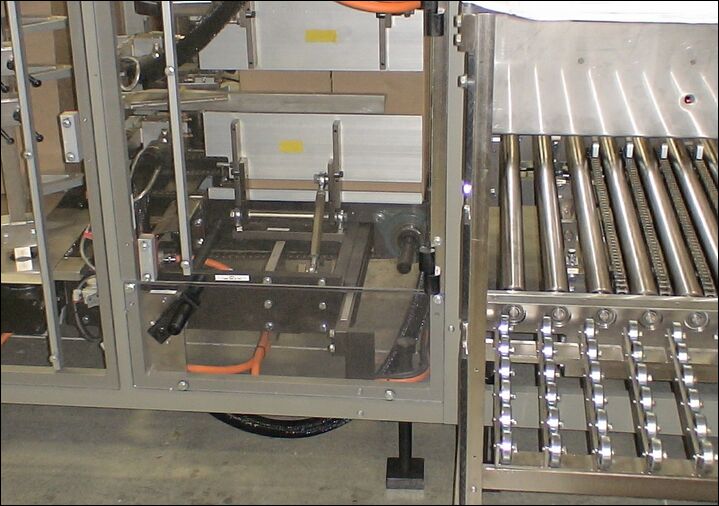
The Lower Compression Non-Operator Side, Lower Compression Operator Side, Upper Compression Non-Operator Side and Upper Compression Operator Side (SM15, SM16, SM17 and SM18) servo motors are all cammed to the case packer main virtual master.
The compression plates fold the horizontal flaps against the glue on the vertical flaps. The flights move the case out of compression and into the orienter while the next case is moved into compression.
ORIENTER
Case Tip/Reject
The case packer flights push the case out of compression onto the Tip/Reject Roller Conveyor (MT1501) in the orienter. As the case leaves the case packer, the Non-Operator Side Open Flap and Operator Side Open Flap (PE51402 and PE51401) photo eyes ensure the case flaps are closed and properly glued. The case is stopped by the Tipper Case Stop (SV50703). If either of the open flap eyes is blocked while the case passes by, the Case Tip R (SM20) retracts and the Tipper Reject Flights (SM19) pushes the case out of the machine. If the case is good, the Case Tip R catches the top, operator side, of the case while the flights push the bottom, non-operator side, out toward the operator side of the machine. This action tips the case toward the backstop (what was the non-operator side of the case is now the bottom). The flights push the case against the backstop and retract, the tipper case stop retracts, and the roller conveyor starts to move the case forward, transferring it to the Case Conveyor (MT50701).
Case Rotate
If the product requires, case rotate is enabled by default.
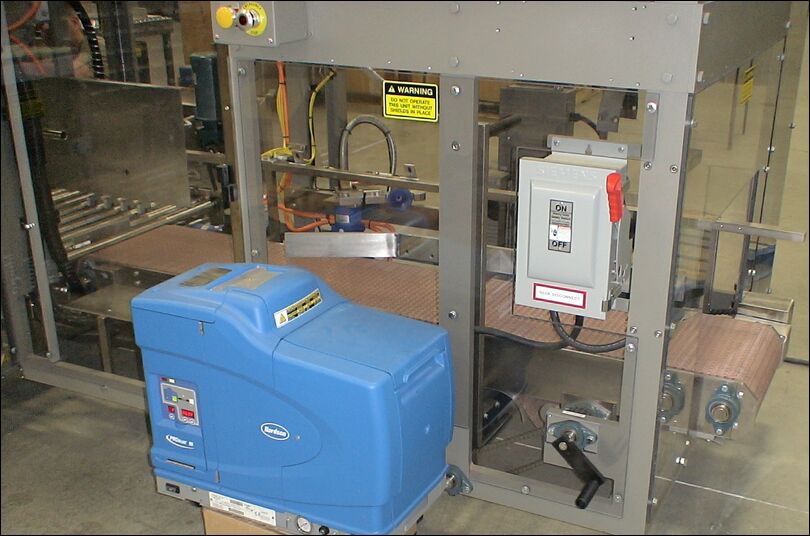
The Case Rotate (SM21) servo motor rotates an arm across the conveyor. The Case At Rotate (PE51505) photo eye senses when a case is approaching the arm. When sensed, the Case Rotate Vacuum (SV50201) solenoid valve is triggered and attaches the case to the arm with a vacuum cup. The arm rotates 90 degrees (¼ turn) counter-clockwise and releases vacuum (what was the operator side of the case is now the leading side). When the case has moved past the Case Present After Rotate (PE51506) photo eye, the arm retracts and waits for the next case.